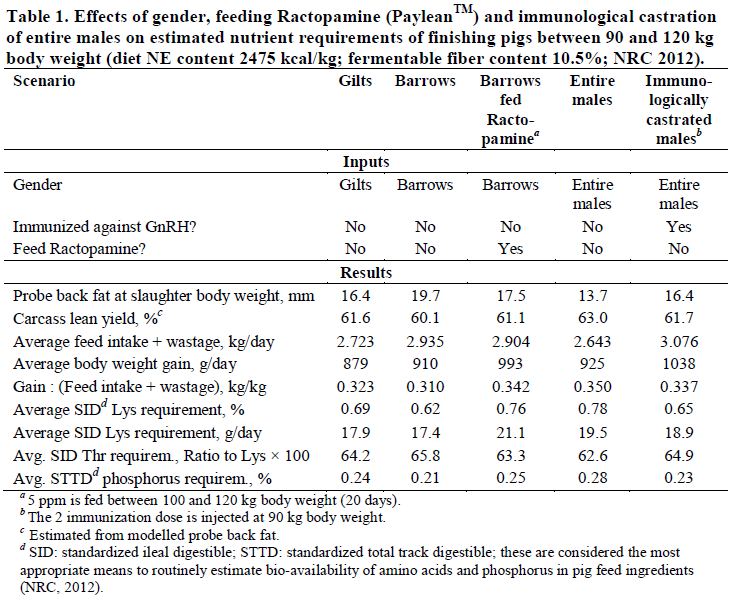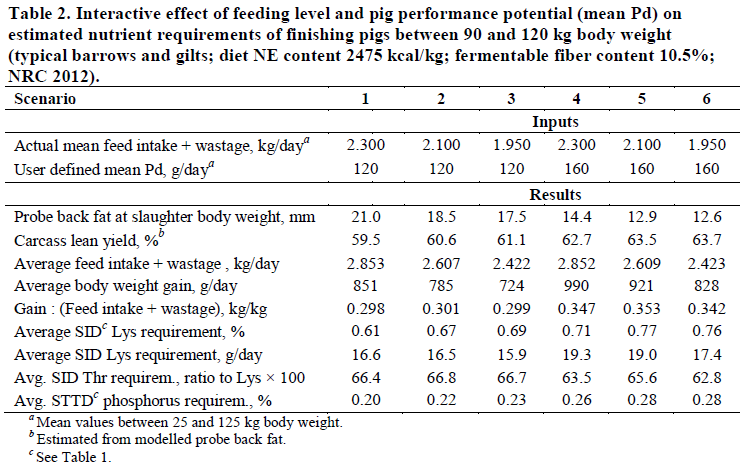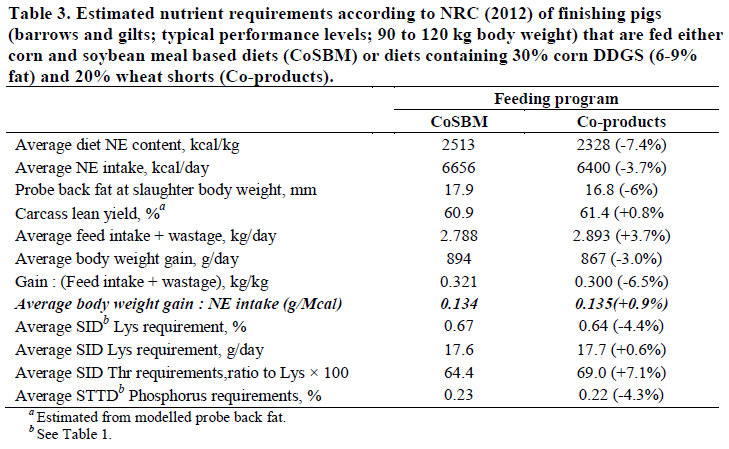



New Tools for Precision Feeding
NRC (2012) nutrient requirements models provide a useful tool to understand the complex interactions between feed intake, pig performance potentials, available feed ingredients, environmental conditions, carcass quality and nutrient requirements, according to C.F.M. de Lange of the University of Guelph. Speaking at the London Swine Conference 2013, he also discussed the limitations of the NRC models in relation to high-fibre feed ingredients.
Summary
The current high feed costs increase the need for developing cost-effective feeding strategies for growing-finishing pigs. Well-tested mathematical models that represent nutrient utilisation for growth allow for a systematic approach to optimising feeding programmes for individual pig units, considering local pig performance potentials and available feed ingredients, as well as environmental and economic conditions.
In this paper, Professor Kees de Lange presented examples are given where the NRC (2012) Nutrient Requirements of Swine model for growing-finishing pigs is used to explore effects of gender, pig performance potentials, feed intake, and use of high-fibre co-products as feed ingredients on nutrient requirements.
These examples stress the need to monitor closely current performance and to evaluate feeding programmes regularly.
Introduction
Feed cost is by far the largest cost in commercial pork production (about 70 per cent), and growing-finishing pigs account for about 80 per cent of feed consumed. The extremely high feed costs in 2012 support the need for developing cost-effective feeding strategies, especially for growing-finishing pigs. As such, the pigs’ performance potentials and maximising utilisation of locally available feed ingredients must be considered to match dietary energy and nutrient supply with the pigs’ requirements to reduce feed cost per kg of carcass weight.
It has been well established that the optimum feeding strategy differs among pig units, and should reflect pig performance potentials, health, gender, available feed ingredients, the pigs’ environments (e.g. space and effective temperature), feed delivery, as well as costs (especially of energy in feed ingredients), pork prices and carcass payment systems.
Examples of the benefit of using models for a systematic evaluation of alternative feeding strategies have been presented in the past (e.g. de Lange et al., 2001; van Milgen et al., 2008). Additional examples will be presented in the two subsequent short papers at this conference, by Drs. Ferguson (Nutreco Canada Inc.) and Marty (Agribrands Purina Canada). In this short paper, the nutrient requirement models from NRC (2012) will be described briefly and estimated nutrient requirements for different groups of pigs are presented.
NRC (2012) Swine Nutrient Requirement Models
The 11th revised edition of the US National Academy of Science book, Nutrient Requirements of Swine comes with three relatively simple models (gestating sows, lactating sows, growing-finishing pigs) to estimate nutrient requirements of different groups of pigs at varying levels of performance and under varying environmental conditions. These models are programmed in Microsoft ExcelTM , are reasonably easy to use, and can be downloaded for free from the internet, with user guide and case studies to illustrate model use (NRC, 2012).
An important feature of these models is that observed levels of performance (e.g. feed intake, growth rate, back fat thickness) and current feeding programmes can be entered in the models and used to adjust model inputs (e.g. the pig’s lean growth potential) to match observed with model predicted performance. When observed performance is in close agreement with model predicted performance, the user can have more confidence in model estimated nutrient requirements. The models can also be used to gain a better understanding of the complex interactions between feed intake, feed ingredients, pig performance potentials, environmental conditions, back fat thickness and nutrient requirements.
As with any model, the NRC (2012) nutrient requirement models have boundaries and limitations, and a basic understanding of their underlying biology is required for effective use. Background information is provided in detail NRC (2012), making all model calculations transparent. For a trained swine nutritionist, it is not too difficult to become familiar with the models, including their limitations.
There are two key limitations of the NRC (2012) models:
- they do not allow cost-benefit analyses, and
- they are unlikely to yield accurate predictions of feed intake.
Given the complex interactions among the many factors that affect feed intake (Torrallardona and Roura, 2009), it is suggested that feed intake is measured and used as a model input and that the model user gains an understanding of environmental factors that should be considered when managing feed intake.
Examples of Nutrient Requirements According to NRC (2012)
Examples of estimated nutrient requirements for different genders of finishing pigs are presented in Table 1.
These nutrient requirements are generated using the NRC (2012) growing-finishing pig model, by choosing default options for each of the genders, defining when (i.e. enter initial body weight) and how much ractopamine (PayleanTM) is fed, or at what bodyweight entire males are immunologically castrated against gonadotropin-releasing hormone (GnRH) to control boar taint. The differences in nutrient requirements provide a basis for split-sex feeding.
The results show that differences in feed efficiency and nutrient requirements between entire males and gilts is larger than that between gilts and barrows. Therefore, as we are moving towards using entire males for pork production the value of split-sex feeding will increase. These results also show the large effect of feeding ractopamine or immunological castration of entire males on growth performance and nutrient requirements.

The interactive effect of feeding level and pig performance potential on estimated nutrient requirements according to NRC (2012) is presented in Table 2.
Performance potentials are expressed as mean whole body protein deposition rates between 25 and 125kg body weight (mean Pd), which is closely associated with lean tissue growth. These results illustrate the importance of increasing pig performance potentials to maximise feed efficiency and carcass value.
These results also stress the need to properly estimating pig performance potentials and feed intake levels for determining nutrient requirements. Underfeeding pigs with high performance potentials or low feed intakes will compromise growth performance, while overfeeding pigs with low performance potentials or high feed intakes represents a waste of expensive nutrients. An interesting observation is that for pigs with high lean growth potentials nutrient requirements, expressed as per centage of diet, are identical at the medium and low feeding levels (scenario 5 versus 6). At these levels of feed intake, pigs are in the so-called energy intake dependent phase of lean gain; in that case the required nutrient to energy ratios are largely independent of feeding level.

The effect of feeding reduced energy and co-product containing diets on nutrient requirements of growing pigs is presented in Table 3.
In these analyses, it is assumed that feeding the reduced energy and co-product containing diets results in reductions in the daily energy intake, as reported previously by De la Llata (2001) and Barnes et al. (2011). As a result, bodyweight gain and probe back fat at the final bodyweight are somewhat reduced. Obviously, feed efficiency will be poorer when pigs are fed co-product containing diets with reduced energy content. However, body weight gain per unit of net energy intake is similar for both feeding programmes. Therefore, feeding programmes should be compared based on cost per unit of energy – whereby all other dietary nutrients are balanced against diet net energy content – rather than feed efficiency.
The data also show that amino acid levels and ratios among key amino acids (e.g. threonine to lysine ratio) should be adjusted when feeding high-fibre containing co-products to pigs. Ultimately, the use of co-products should be determined based on cost-benefit analyses, considering effects on carcass value, ingredient costs and the value of throughput in the growing-finishing barn. Such cost-benefit analyses will be addressed in subsequent papers in this workshop.

Conclusions
- The current high feed costs increase the need for developing cost-effective feeding strategies for growing-finishing pigs.
- Modelling nutrient utilisation allows for a systematic approach to optimise feeding programmes for individual pig units, considering local pig performance potentials and available feed ingredients, as well as environmental and economic conditions.
- NRC (2012) nutrient requirements models provide a tool to better understand the complex interactions between feed intake, pig performance potentials, available feed ingredients, environmental conditions, carcass quality and nutrient requirements; these models can be used to estimate the unique nutrient requirements for individual groups of pigs.
- Two key limitations of the NRC (2012) models: (1) they do not allow cost-benefit analyses, and (2) they are unlikely to yield accurate predictions of feed intake.
- Performance of growing-finishing pigs (feed intake, growth, and carcass quality) should be monitored closely and feeding programmes should be evaluated regularly.
References
Barnes, J.A. 2011. Effects of dietary wheat middlings, dried distillers grains with solubles and choice white grease on growth performance, carcass characteristics, and carcass fat quality of grow-finish pigs. M.Sc. Thesis. Kansas State University, Manhatten, KS, USA.
De la Llata, M., S.S. Dritz, M.D. Tokach, R.D. Goodband, J.L. Nelssen and T.M. Loughin. 2001. growing-finishing pigs reared in a commercial environment. Effects of dietary fat on growth performance and carcass characteristics of growing-finishing pigs reared in a commercial environment. J. Anim. Sci. 79:2643-2650.
de Lange, C.F.M., B.J. Marty, S.H. Birkett, P. Morel and B. Szkotnicki. 2001. Application of pig growth models in commercial pork production. Can. J. Anim. Sci. 81: 1-8.
NRC (National Research Council) 2012. Nutrient requirements of swine. 11th revised edition. National Academic Press, Washington, DC.
Torrallardona, D. and E. Roura, eds. 2009. Voluntary feed intake in pigs. Wageningen Academic Publishers, Wageningen, The Netherlands.
van Milgen, J., J. Noblet, A. Valancogne, S. Dubois and J.Y. Dourmad. 2008. InraPorc: a model and decision support tool for the nutrition of growing pigs. Anim. Feed Sci. Techn. 143: 387-405.
Further Reading
You can view other papers presented at the 2013 London Swine Conference by clicking here.
October 2013








